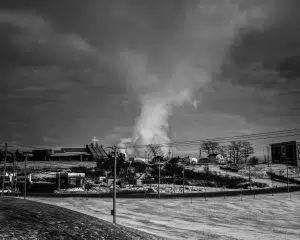
Photo credit from The Cloud Factory (Credit: Chris Donovan)
Close your eyes and picture a scene from the Maritimes. Got it?
The picture you see might be different from others who grew up in some parts of the region.
Through art, people, communities and cultures can challenge existing narratives by expressing their own visual truth instead of painting a post card picture.
In recent years, Saint John artists have drawn inspiration from industrial elements, both physical and intangible, to expand the identity of Atlantic Canadian art from what most Canadians believe it is.

Artwork from Limit of View (Credit: Elizabeth MacLeod)
“Overall, I’m just really interested in regionalized identity and how we define ourselves here compared to the rest of Canada,” said Sarah Jones, artist and Curator of the Jones Gallery. Jones’ first solo exhibition, “Limit of View,” debuted in November 2019 and captured the industrial elements of East Coast horizons.
She found the industrial landscapes of Saint John visually compelling, drawing upon Courtenay Bay and Tin Can Beach, “These kinds of these places where they would never show up in a tourism brochure.”
Jones is also interested in how industrial landscapes work in terms of a Maritime collective identity.
“It resonates with us again for a variety of reasons, and has formed a part of our childhood identity. I guess it says something about us, and we’re all just trying to parse into that, like, the good, the bad, how they work together,” she said.
Her artistic ideology is echoed by photographer Chris Donovan, the youngest person to win the Photographers Association of Canada’s Photojournalist of the Year and Picture of the Year in 2017, who’s also one of the few Maritimers to do so. His portfolio includes award winning stories from Saint John, such as “Patricia’s Dolls.”
While Jones’ artwork is influenced by industrial landscapes and recreating them, Donovan’s photographs show the impact that industrial culture has had on communities, from Flint, Michigan to Kenya to Mexico.
“The Cloud Factory,” Donovan’s long-time project focusing on the city’s Bayside neighborhood, is about industrial classism in Saint John and how growing up in heavy industry influences one’s worldview.

Photo credit from The Cloud Factory (Credit: Chris Donovan)
“I think that almost all Maritime art is in some way influenced by industry because the Maritimes are like a blue-collar region,” he said.
“The main thing that ties them together is that the first thing you think about is how to secure the bag, how to have food on your table, said Donovan, “And then the other things are secondary. Those secondary things are what Sarah and I both are trying to address with our art, which is that it’s hard to see the forest through the trees a little bit.”
Donovan’s father comes from rural Cape Breton, and with a major industry in fishing; he ended up doing a History Masters in fishery, which Donovan believes was due to being subconsciously influenced by the industry most people worked in.
“Even though he wasn’t a fisherman, it had an effect on him so I think that no matter where you are in the Maritimes, some kind of industry will have a subconscious effect on you. In Saint John it happens to be heavily industrial industry, oil, lumber,” Donovan said.
Donovan and Jones’ art questions the image of Atlantic Canadian art appearing to be comprised of quaint fishing villages and ocean landscapes, despite the popularity of the aesthetic. Donovan believes the Maritimes has a layer of industrial importance to the whole country that people outside of Atlantic Canada don’t see.

Photo credit from The Cloud Factory (Credit: Chris Donovan)
“That image of Peggy’s Cove and the Covered Bridges is more of an image from outside of the Maritimes, and how we’re perceived,” he said.
Jones echoes his viewpoint, wanting to broaden what it means to be Canadian. “There’s a danger in linking the work to an essence of “Canadian-ness” and things like that, that this art equals identity.”
“I think there’s the danger in like holding it up as ‘this is what the Maritimes are’; that’s not the entire picture is what I’m trying to say with my work,” she said.
She believes the rise of industrial elements in Maritime artists is an effect of, “I think maybe, me and the other artists here in this region kind of questioning our industrial heritage. It’s just part of this larger trend of just asking questions like pushing back against the received narrative we’ve had for centuries.”
Donovan adds, “When I look at the art being made in the Maritimes that’s not reflected but certainly being in Toronto, that is like how people perceive the Maritimes for sure.”
“One of the biggest reasons that art is important, in my opinion,” continues Donovan, “Is that it challenges our biases and our ideas about the places that we live and the ideas that we’re given.”






